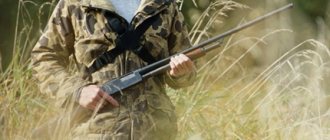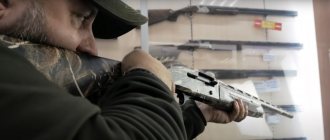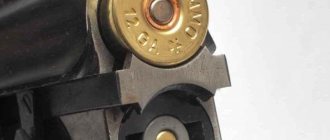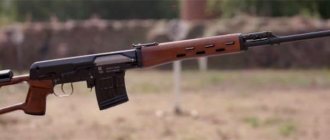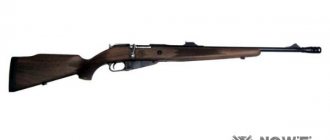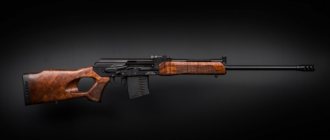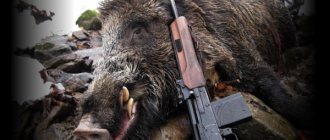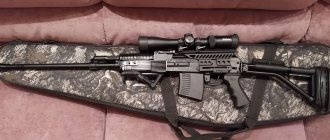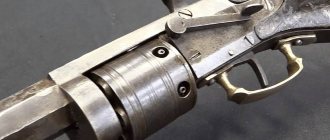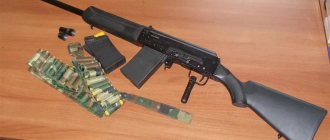A new video has been released on our Youtube channel, in which hunting department expert Sergei Pisarev spoke about civilian weapons in “quasi-rifling” calibers.
Such carbines are equipped with barrels with “paradox” or “lancaster” drilling and at a distance of up to 200 - 300 meters they show accuracy comparable to rifled weapons. Until July 2, 2022, weapons of this class can be purchased under a “smoothbore” license without a five-year experience.
Previously, we covered in detail the topic of weapons in .366 TKM and other similar calibers. Read our materials, from them you will learn all the necessary information about the models, cartridge capabilities, technical characteristics, and the use of such carbines for hunting.
- All about the .366 TKM caliber: overview of features, ammunition and weapons
- Lancaster: “undercut” or a full-fledged replacement for rifled weapons? Review + video
- “Saiga TG2” in the new .366 Magnum caliber
- “Saiga TG2” in caliber .366 TKM
- Review of the Saiga TR3 .366 smoothbore carbine: first look, design, assembly, pros and cons
- New items from VPO “Molot” in caliber 9×22 Altay
- Orsis AR15J carbine in .366 TKM caliber
- “VSS Vintorez” from TOZ: the legendary special forces weapon is now available to you
- Saiga carbine TR9 Paradox 345 TKM
Video
Attention!
If the desired model of gun is not in stock, we can always bring it to order. 15% discount on Lancaster weapons from
To solve hunting problems, more than 500 types of weapons are available in the World of Hunting chain stores. We have smoothbore guns, rifled carbines (including small-caliber ones), pneumatics, accessories from Russian and foreign manufacturers. Come and make your choice!
The reference article is based on the expert opinion of the author
Paradox. Can a shotgun be legally converted into a rifled carbine?
What is the weapons “paradox”? These are rifling in the muzzle narrowing specifically for firing a bullet from a smoothbore weapon. The rifling spins the ejected bullet and stabilizes its flight. Such a bullet flies further and hits more accurately, hits harder...
“Paradox” is a fairly old invention. The rifled choke was invented in 1885 by British Army Colonel George Vincent Fosbury, a hunter and traveler. The colonel himself called it Riflid Choch. Then the patent was bought by the arms company Holland & Holland. And in order to distance herself from the name “Fosbury” after purchasing the patent (that was already the name of the English revolver “Webley-Fosbery Automatic Revolver”), she called it “Paradox”. The same name was given to a large-caliber smoothbore shotgun for hunting large game from Holland & Holland.
Such “paradoxical” guns were produced in 8, 10, 12, 16 and 20 calibers, i.e. the entire line of calibers that are used for hunting large animals. By the way, these guns were very popular in pre-revolutionary Russia. In addition to England, at the beginning of the 20th century such guns were produced in France, Belgium and Germany. Then their production began to decline and by the beginning of World War II it practically ceased. Why? But because at the beginning of the century, hunting cartridges were loaded with weak black powder. With the advent of strong smokeless powder and the widespread use of rifled weapons, all the advantages of the Paradox gun were exhausted. The Holland & Holland company itself produced Paradox brand guns until 1933.
The modern “paradox”, like a replaceable muzzle attachment for a regular gun, appeared in the 60s of the 20th century in America. However, they did not become widespread there; a fully rifled barrel performed the functions for which this attachment was made much better. And there are no restrictions such as in Russia (for example, a license for a rifled barrel can be obtained only after five years of owning a smooth barrel). Ruzhzho and ruzhzho, what difference does it make whether the barrel has rifling or a smooth one? And in Russia, until recently, such a “paradoxical” method of hunting was not much favored.
Everything changed with the start of production in Russia of “small-caliber” smoothbore shotguns of 410 (10 mm) caliber. Shotguns of this caliber began to be produced en masse in the 90s of the 20th century. Weapons chambered for this cartridge are made primarily with a short barrel and are used not so much for hunting as for recreational shooting (plinking) and sometimes self-defense. It is on the light and long 410 caliber bullet that all the advantages of the “paradox” are manifested; the bullet flies about a third further and hits the target more accurately. What else do you need at entertaining shootouts? Demand, as we know, creates supply. Following the 410 caliber, paradox attachments began to be produced for other smoothbore calibers.
Advantages . Well, everything described above.
Even a gun equipped with a “paradox” attachment remains a smoothbore. This means that the restrictions inherent in rifled weapons do not apply. After all, here in Russia, even during the hunting season, you can’t walk through the forest with a carbine. You need a license to hunt large animals, the cost of which reaches several tens of thousands of rubles (for example, 25,000 rubles for a deer). And for a duck, for a regular gun, in our Rostov region (autumn 2011) a license cost... as much as 200 rubles. For the fox 50...
And one more significant advantage of the “paradox”. Everyone knows how important an accurate shot is when hunting a large game. So, when using the “paradox”, the hunter can make a variety of different cartridges himself, shoot them and, by choosing the desired amount of gunpowder and the type of bullet, can slowly produce the required amount of ammunition.
This trick will not work with a rifle; the manufacture of ammunition for rifled weapons is prohibited by law. You can earn up to three years! At the same time, the quality of cartridges for rifled weapons is not stable, and, having found the necessary ammunition, the hunter is forced to immediately stock up a huge amount of cartridges from this particular batch, spending quite a significant amount on this, since another batch of ammunition from the same manufacturer may have different characteristics. So, hunting with rifled weapons, especially in Russia, is a rather expensive hobby.
Flaws . A shotgun with a paradox attachment does not replace a rifled weapon. It only increases the flat trajectory of the bullet, increasing the accuracy of hitting the target. Firing range over 80 m is a distance only for rifled weapons.
When firing a regular lead bullet, short riflings quickly become clogged with lead, and cleaning them is still a “pleasure”... However, they are now producing special “clean” bullets, the metal body of which is packed in a durable casing.
Cutting the connecting thread on domestic “paradoxes” is far from ideal; sometimes the nozzle has to be further modified.
When shooting with shot, the spread of the shot is significantly higher than in a conventional, unrifled, choke.
Paradox is only effective for long bullets. Such a bullet will not tumble in the air when rotating, and as it passes, it will twist more strongly in the rifling. On a bullet-ball, the effect of the nozzle will be completely unnoticeable.
The “paradox” only works when firing caliber bullets. A sub-caliber bullet in a plastic container will only lose its ballistic characteristics.
And finally, look at how many problems the “paradox” attachment solves. Firstly, it increases the range and accuracy of the shot. Secondly, show off - well, it’s nice to feel that you have “almost a carbine” in your hands. It also saves big game hunters money.
There are just limitations that you need to remember. Always.
Tags: history of weapons, shooting, hunting, weapons, inventions, bullet flight
What qualities have been attracting the attention of hunters to the “paradox” for about 100 years?
First of all, this is the opportunity to have a good bullet shot at a large animal from the same familiar gun with which they hunt game birds. With normal loading of cartridges, the “paradox” gives a shotgun shot of any shot number as a cylinder with pressure or even as a shot and a fairly accurate bullet up to 150m, which is almost enough for any hunting of animals in a forest area.
The fact that “paradoxes” have a good shot action is quite understandable: a short rifle with wide fields and rifling does not have time to impart rotation to the shot shell, since the main part of the pellets slides freely along the wide fields and rifling.
A good bullet fight depends on the width, depth, pitch and shape of the rifling, the gradual transition from the smooth to the rifled part of the barrel, the design of the bullet and the material from which it is made, as well as on the speed at the moment the bullet hits the rifling. Passing along the rifling after the smooth part, the bullet receives a rotational movement as it leaves the barrel.
Double-barreled "paradox" 1 caliber.
Work by F. O. Matski. St. Petersburg 1980s.
Experiments
Experiments have shown: in order for a bullet in a “paradox” type choke at modern initial speeds to receive the rotational motion necessary for stabilization in flight, it is necessary to have a rifling of slight steepness and a length of at least 10-12 cm, which will make the gun unsuitable for shooting shotguns at long ranges over 15-18 m. In the 1960s. (USA) experimented with attached rifled chokes for single-barreled repeating and self-loading shotguns.
A rifled choke was created approximately 12 cm long. It had eight wide riflings, so that the brim was only about 1.5 mm wide; in this case, the cutting pitch was about 48cm. Passing through the choke, the bullet turned only a quarter of a turn. Such a check attachment was intended to improve the accuracy of combat with Foster bullets (weight 28g for 12 gauge).
The console was not widely used and its production was discontinued. As for the original guns and bullets of the “paradox” type, in England, where these guns were created, they were produced only in large calibers: 4, 8, 10 and 12. The bullets were lead, conical in shape and in the vast majority of cases were filled with brass cartridges, since this ensured reliability against jamming of cartridges in critical situations.
The last shootings and measurements of the characteristics of these guns and bullets noted in foreign literature were made in 1976-1978. weapons expert J. Lott. Data published in Gene Digest for 1979. Trying to adjust the bullet speeds to modern standards, Lott brought the black powder weights to the maximum allowable both in weight and in the possible volumes of metal cartridges.
Here are the results he obtained when shooting “paradoxes”:
| Weapon caliber | Bullet weight is a paradox. G. | Diameter, mm | Weight of black powder. G | Initial speed, m/s | Muzzle energy of a bullet. kgf/m |
| 12 | 48,6 | 18.4 | 12,37 | 472 | 644 |
| 12 | 47.6 | 18,4 | 7.9 | 350 | 279 |
| 10 | 56.7 | 19.6 | 14,1 | — | — |
| 8 | 81 | 22.2 | 17.6 | 457 | 869 |
Accuracy shooting was carried out from a distance of 22m; the accuracy at this distance was high (the holes touched the edges). For comparison, Lott provided data on the firing of a 12-gauge shotgun with a bore diameter of 18.4 mm with a ball bullet weighing 37.9 g. This bullet, with a black powder charge of 12.37 g, had an initial speed of 487 m/s and a muzzle energy of 459 kgf/m . Guns for shooting "paradox" bullets were made much heavier than usual - 12 gauge - about 5 kg, 10 gauge - 6 or more kg, 8 gauge - 7-8 kg. Paradox bullets give a very significant reduction in trajectory: at 100m - 50-60 cm for a 12-gauge bullet; up to 100 cm and more - 8 gauge. Paradox bullets were not tested with smokeless powder.
If we take into account that with the size and weight of the “paradox” bullet, no more than 7 g of gunpowder can be placed in a paper sleeve (and most modern guns have barrels drilled equal to the internal diameter of the paper sleeve), then it is unlikely that we will be able to obtain results even such as we have when firing from smoothbore guns with currently produced bullets.
From the history of the creation of chokes and paydays
The inventor of chokes is considered to be American duck hunter and fisherman Fred Kimble. In 1870, he was disappointed with the scree produced by a gun with a classic cylindrical drill. It gave birth to the assumption that by narrowing the muzzle, it was possible to give the scree a more precise direction and achieve greater accuracy of the shot.
After Kimble narrowed the barrel of his 10-gauge shotgun, the results got even worse. He immediately decided to get rid of the narrowing, but since the American hunter did not have precise measuring instruments on his hands, he did not succeed completely. Deciding that the gun had returned to its classic parameters, he fired a test shot. The result was amazing - the shot was heaped and dense.
It turned out that there was still a slight narrowing left in the trunk. which led to such a serious difference in shooting. Fred Kimble did not patent his choke technology. But it is known that this was done a little earlier by a gunsmith from the other side of the world - the British Marcus Pape, back in 1866.
Pape's technology was based on a cone-shaped narrowing of the barrel. He measured the difference between the internal and external diameters of the barrel in a standard unit of caliber, and the distance from the muzzle to the narrow part was 2.5 cm. Since then, in Europe, the choke technology has been called conical, and in the USA - American.
Paradox or Lancaster: what to choose?
Today Vyatka remains the main manufacturer of carbines with similar drills. Such carbines are produced by their neighbors from, as well as the Kalashnikov Concern. Most of them are produced in two calibers - 366TKM and 9.6x53 Lancaster.
Paradox or Lancaster: pros and cons
Advantages of cutting Paradox:
The disadvantages include:
Pros of cutting Lancaster:
I prepared the original answer to the question from the title of this article. In the near future, she plans to release for sale a carbine with a combined barrel, combining both types of drills - first Lancaster along the entire length of the barrel, and Paradox in the muzzle. All that remains is to wait for the new product and try it in action. Perhaps the new model will be the perfect combination of both systems and a new word in this segment. In this case, there will definitely be a demand for it - after all, there will always be those who want to acquire an almost rifled carbine without a “red” license.
Material prepared by Arkady Bobrovsky, editorial photo
Source
Lancaster drill
Pros:
v Powerful caliber makes it possible to hunt large animals.
v The bore is easy to clean thanks to its special shape.
v At longer distances, stability and accuracy are improved. Ballistic characteristics are improved.
v Compared to drilling, Paradox Lancaster is more reliable, and the incidence of ruptures and swelling of trunks is significantly reduced.
Minuses:
v Strong recoil and increased shot volume.
v Soft cartridges are highly deformed and accuracy is significantly impaired.
Note
What is a Lancaster drill?
Charles Lancaster's drill looks like this: in the smooth bore of the barrel there are two opposite semicircular riflings, which are twisted a certain number of turns, just like with conventional rifled barrels. Due to the smooth transition of the rifling into the walls of the bore, it seems that the bore is oval, which is why this rifling is sometimes called “oval-screw”.
Barrel profile with Lancaster drill
This drill was developed for the needs of artillery in 1850, its purpose was to facilitate the loading of muzzle-loading guns and increase the initial velocity of the projectile by reducing friction on traditional rifling. The idea caught on, and such guns were produced until 1900, until they were completely replaced by breech-loading guns.
Barrel with Lancaster drill for light
Was designed
The 24-caliber “paradox” was designed by S.A. Buturlin and manufactured by F.O. Matskaya and began producing “paradoxes” from Lebeau, Fremcott, Liège Manufactory (Belgium), Verneuil Carron (France) and others. Gradually, a remarkable improvement in the accuracy and range of the "paradox" bullet was achieved.
Thus, the 12-gauge “paradox”, called “Explora”, produced by Westley-Richards, had a bullet weighing 48 g with an initial speed of 400 m/s and at a distance of 273 m it placed all the bullets in a square of 29 X 29 cm. Agree that this is great . Somewhat later, the same 28 caliber, which received the name “Favneta”. This gun had a fairly good shotgun shot up to 25m and excellent firepower with a special bullet.
Bulletley
for the "paradox" 20 gauge.

